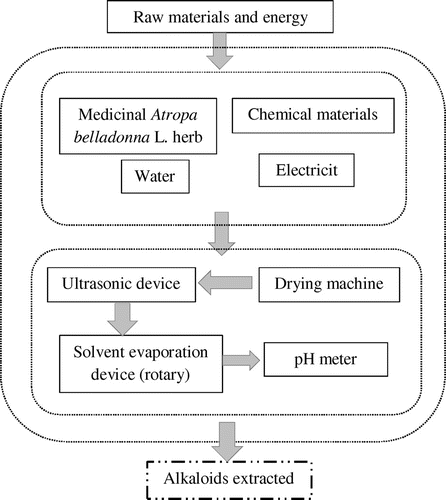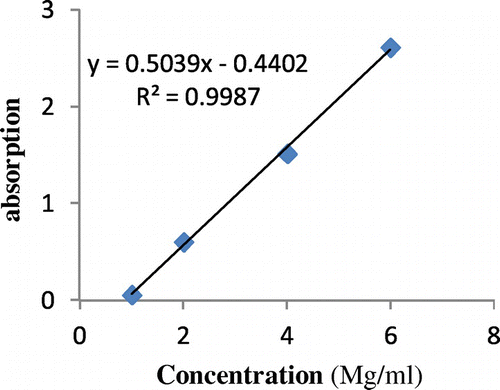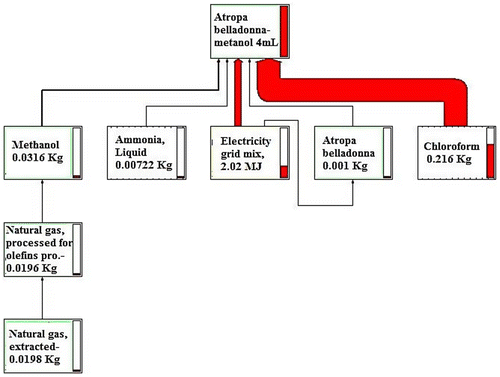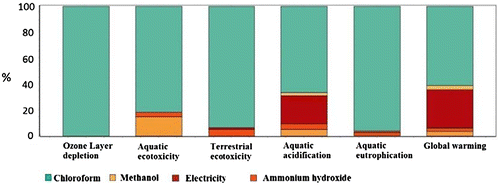Abstract
In recent years, evaluation the effects of alkaloids extraction on the environment is considered regarding the importance of environmental issues. Tropane alkaloids such as hyoscyamine and scopolamine have many applications in the medical field. The purpose of the present study is using the Life Cycle Assessment (LCA) in the environmental impact assessment of total alkaloid extracted from Atropa belladonna, so all the usable materials and technologies as well as the diffusion of various substances into the environment were estimated for 6.2 mg total alkaloid extract. The LCA model was developed with the application of SimaPro 8.1 software, for analysing the data resulted by the IMPACT 2002+ method. The IMPACT 2002+ impact assessment method, comprising of two sets of impact categories, eighteen midpoint-level impact categories (e.g., climate change, ozone and water depletion, eutrophication, and particulate matter formation), and three endpoint categories (damage to human health, ecosystem diversity, and resource availability). Based on the results of this study, it was found that green processes should be used for extraction of alkaloids, and based on the effects of chloroform used in the extraction process, the chemical materials with minimal damage to the environment must be replaced.
Introduction
In last decades, the life cycle assessment (LCA) has been an important issue in managing environmental impacts. Due to the important effects of tropane alkaloids on human health, the evaluation of the environmental effects of extraction of alkaloids from the Atropa belladonna L. plant is essential (Aghajani, NejadKourki, Sotoudeh, & Hosseini, Citation2015). The plant A. belladonna is a perennial herb, with long, conical roots. The height of the plant varies from 100 to 200 cm in different climatic conditions. In this plant, the leaves are alternate and egg-shaped and scattered throughout the stem (Omidbaigi, Citation2005). The plant A. belladonna is from the Solanaceae family that containing Tropane alkaloids. The Tropane group alkaloids, such as atropine and scopolamine alkaloids, are the derivatives of ornithine (Aniszewski, Citation2007). The plant is used in pharmaceutical industry for the treatment of conjunctivitis, biliary disease, urinary tract, and asthma and also to the relief of severe pain (Rajput, Citation2013). The Atropine in the plant is used to counteract the effects of ester phosphoric acid, which is commonly used to spray plants against pests. Due to the importance of this plant and its economic significance, this plant is cultivated in many European countries, every year (Omidbaigi, Citation2005).
In different methods, the extraction process was performed to obtain the antioxidant of rosemary leaves, LCA done by researchers. Comparison of the environmental effects of the three methods in the functional unit of 10 grams of Rosemary leaves extract was performed to introduce the optimum extraction conditions. Extraction of antioxidant compounds by environmentally friendly techniques was investigated in this study that is known as green process (Rodríguez-Meizoso et al., Citation2012).
A study of the cradle-to-gate LCA of the three types of enzymes used in the chemical composition of drugs was done by Kim et al. The effects of life cycle for non-renewable energy consumption, global warming, acidification, eutrophication, and photochemical smog production were evaluated per kg of these enzymes per functional unit (Kim, Jiménez-González, & Dale, Citation2009).
LCA CO2 emissions of different energy carriers were performed under the same unit 1Gj in China. Coking products, oil products, middling coal, cleaned coal, natural gas and crude oil, and raw coal are types of fuels for use in energy carriers. Coking products have the largest CO2 emission among other fuels (Sun et al., Citation2014).
The LCA is a method to evaluate all the environmental effects associated with a product in its entire life cycle from the stage of extraction or collection of raw materials to the stage of consumption, and then the recycling or disposal of the resulting waste. In this method, with careful examinations, all resources consumed for the production of the product and all materials released into the environment are evaluated quantitatively. Also, the environmental indicators such as carcinogens, respiratory organic, respiratory inorganic, climate change, radiation, ozone layer depletion, ecotoxicity, acidification, land use, minerals, and fossil fuels are investigated (Jolliet et al., Citation2003).
Due to the scope of LCA, the life cycle is investigated from cradle to grave, cradle to gate, and gate to gate. In the sense of cradle-to-grave period, it covers all stages of life from production of raw material to final disposal or recycling. For a specific unit of a medicinal plant, the LCA consists of its growth in the forest, harvesting, processing, transportation, use, recycling, and final disposal. For the cradle to gate, it comes with the production of raw materials up to the production of the desired product while for the gate to gate, only production sage is taken into account (Abbasi, Zarea Hosseinabadi, & Mousazadeh, Citation2016).
There are four stages in the study of LCA, including goal and scope definitions, inventory analysis, impact assessment, and interpretation. Defining the goal and scope is the most important part in the LCA. In this step, the determined parameters are the goals of the study, the desired final product, the boundaries of the studied system, the functional unit, and the assumptions of the study. In the stage of analysis of the collected data and calculation procedures are done to quantify the inputs and outputs associated with a product system during its life cycle. The impact assessment stage includes the importance and value of the potential environmental impacts of a product system using the results of the life cycle analysis process. Finally, at the stage of interpretation, the findings of the inventory analysis and the impact assessment are evaluated either individually or both together, which in accordance with the goal and the scope of the application define the constraints and present the recommendations (Soltani, Rajabi, Zeinali, & Soltani, Citation2010).
The purpose of this study was to assess the environmental effects of alkaloids extracted from the Atropa belladonna L. plant. Regarding the economic significance of alkaloids in the pharmaceutical industry and its increasing use in improving human health, it is necessary to carry researches in order to the reduction in environmental contamination..
Materials and methods
In this research, the stages of LCA are described according to ISO standard:
Step one – goal and scope definition: The purpose of the LCA was to indicate the environmental impacts of total alkaloids extraction from the Atropa belladonna L. plant. Selection of the plant type was due to the importance of atropine and scopolamine in the plant, which are considered as the valuable alkaloids. In this research, the gate-to-gate LCA was performed due to the inaccessibility of the raw material information, final product recycling, and disposal (Engelbrecht, Thorpe, & Mearns, Citation2012).
The boundary of the unit system determines the processes of a part of the product system, as shown in Figure . A functional unit is the quantitative unit of the performance of goods or services as well as the use of this function which is used in the study. The functional unit in the present study is based on the volume produced from the extracted materials of the plant Atropa belladonna L. that expressed as concentration (Wang, Xia, Zhang, & Liu, Citation2010).
The estimation of environmental impacts such as carcinogens, climate change, stratospheric ozone depletion, acidification, and land use is modelled by using SimaPro software (Jolliet, Saadé-Sbeih, Shaked, Jolliet, & Crettaz, Citation2016).
Step two – inventory analysis: The plant was collected in Ramian region (36° 50′N, 55° 13′E) in Golestan Province, in northern Iran. The drying of the plant Atropa belladonna L. was carried out by a hot air dryer in a postharvest laboratory, College of Abouraihan, University of Tehran. In order to extract alkaloids, an amount of 0.5 g of the powdered materials obtained from Atropa Belladonna L. put inside the Falcon tube, then 40 ml solvent containing 15 ml of chloroform, 5 ml of methanol, and 25% ammonia 15:5:1 (v/v/v) was added to materials (Hank, Szoke, Toth, Loszlo, & Kursinszki, Citation2004). Then, the samples were placed in ultrasonic device for 10 min. The samples were kept at room temperature, and after one hour, the surface layer on liquid was taken, and the solvent was added to the remaining powder again, and the previous step was repeated. The extracted samples were filtered by passing through the paper, and the remaining powder on the filter paper washed twice with one millilitre of chloroform. For separation of the solvent, the extract was placed in a rotary balloon to dry extract, and then, five millilitres of chloroform plus two millilitres of sulphuric acid were added to the extract and shook until it’s thoroughly mixed and then moved to a Falcon tube 15, and by removing the chloroform phase from the mixture and transferring the acid phase to the tube or the new Falcon tube, its pH increased up to 10 by adding ammonia 28% over the ice (Bahmanzadegan, Sefidkon, & Sonboli, Citation2009). Then, two millilitres of chloroform was added and mixed with the sample, and the chloroform phase was separated and filled in a new container. Once again one ml of chloroform was added to the sample to have higher accuracy. An amount of 1 mL of chloroform was added once again to increase the precision and, by forming a two-phase solution, the chloroform phase was separated. Dehydration of the extract was done with dry sodium sulphate and purification of the extract by filter paper and by adding 1–2 ml of chloroform to the remaining materials on the filter paper (Ashtiania & Sefidkon, Citation2011). Finally, by evaporation of chloroform, the sample was dissolved in 2–1 ml of methanol.
Spectrophotometric method was used to determine the total alkaloids content of the plant extract. The standard curve was plotted using alkaloid atropine (Sigma-Aldrich) and different concentrations of the material at 258 nm wavelength (Figure ) (Karimi, Amini Eshkevari, & Zeinali, Citation2009).
System inputs
Considering the extraction of alkaloids, the used tools were a hot air dryer, ultrasonic, rotary, pH meter, ice maker, electric mill, and balance that each of them has different energy consumption. The energy of each device was obtained separately, and the total energy was considered for the analysis in the SimaPro program (Table ).
Table 1. Amount of energy and water used in the extraction of alkaloids.
The amount of water consumption was calculated for cooling system of the rotary device as well as the water which was used in Ben Murray of rotary device and ultrasonic device to keep the samples at the desired temperature. The amount of water consumption was considered as the natural inputs of the program (Table ).
Table 2. Amount of chemical material consumed in the path of extraction of alkaloids.
Step three – impact assessment: In this stage, the method of IMPACT 2002+ available in the program was used to inventory analysis of the life cycle. The results of the life cycle inventory analysis were grouped into 15 categories that these classifications are midpoint categories and then subgrouped into the four damage categories of human health, ecosystem quality, climate change, and resources (Figure ) (Jolliet et al., Citation2003).
Figure 3. General scheme of the IMPACT 2002+ framework, communicating the results through 14 midpoint categories to four damage (Jolliet et al., Citation2003).

Step four – interpretation: Finally, the results are interpreted as the basis for the conclusions and suggestions in accordance with the definition of the goal and scope. The weighing method was used to interpret the results. According to IMPACT 2002+, if accumulation is required, the weighted factors are determined or one default factor is considered. In this study, weight factors of 1: 1: 1: 1 were considered (Gaidajis & Angelakoglou, Citation2011). For attaining more information about IMPACT 2002+, see reference at the end of the article (Du & Karoumi, Citation2012).
Results and discussion
The network model developed of extracting alkaloids in the software was investigated for evaluating specific processes (Figure ). Every node in this network consists of a number of materials and processes, which are analysed. The lines between the nodes express the internal connection. The width of the lines (thickness) represents the environmental burden (expressed as a percentage or as a thermometer bar on the right), and thick lines express significant environmental impact (Gaidajis & Angelakoglou, Citation2012).
The analysis is based on the choice of the impact assessment method, and the results obtained from all the normalized and weighted impact category were summarized in the Single Score section. The most important results that can be obtained from the alkaloids extraction network are as follows:
| • | The use of chloroform in extraction of alkaloids has high environmental burden. | ||||
| • | Due to the fact that for this extraction the functional unit is considered to be quantity, the use of mineral resources is very necessary. | ||||
| • | As seen in the network, the electrical energy after chloroform has high environmental impact. | ||||
Impact category global warming
Global warming is in the damage category of climate change. Greenhouse gases are released through human activities, and as a result, creating a layer in the atmosphere and trapping the rays of the sun cause the global warming. Therefore, the heat that is supposed to be reflected in space is trapped in the troposphere and causes an increase in the temperature in the troposphere, while the temperature in the stratosphere was came lowered and Ozone layer molecules were accepted damaged by harmful gases. This results in the destruction of the ozone layer. Impact category Global warming causes increasing sea levels, dangerous weather events (intense floods, storms ...), changes in the ecosystem, and increasing heat-related diseases in temperate regions and strongly melted the glaciers. Indicator GWP emission gases such as methane, nitrogen oxide, carbon dioxide, and chlorofluorocarbon in terms of carbon dioxide are shown. For example, 1 kg of methane is related to 25 kg of carbon dioxide (GWP100a). The simulation of the greenhouse gases’ time horizons for the different time periods of the life of troposphere indicates the term of the validity of the calculation. The time horizons for global warming are usually estimated at 20, 100, and 500 years (Almeida, Degerickx, Achten, & Muys, Citation2015). The time horizon of GWP100a is selected usually to evaluate the life cycle, while it is possible to employ the shorter or longer horizons for different purposes with respect to the defined goal (Klöpffer & Grahl, Citation2014). Results show the life cycle enzymes in pharmaceutical products. By using biobased glycerin instead of petroleum-based glycerin, the impacts of global warming decrease between 11 and 44% (Kim et al., Citation2009). According to Table , the effect of chloroform production and the production of electrical energy in global warming has been high, although other factors have also had an effect of about 3%.
Table 3. Amounts of indexes impact category in evaluating life cycle effects for extraction of 2.6 mg total alkaloids.
Impact category ozone layer depletion
A short wavelength solar radiation of about 300–290 nm to earth’s surface reduces the thickness of the ozone layer in the stratosphere. The destruction of the ozone layer is based on the formation of chlorine and bromine molecules in the stratosphere by the chemical decomposition of volatile and stable particles due to radiant force. An ODP value is used to the quantification of relative activities of ozone layer depletion substances, which indicates the amount of ozone layer depletion. CFC-11 or R11 optionally is defined as a contract for ODP like GWP of carbon dioxide. ODP is calculated for N2O as 0.017 kg equivalent of CFC-11 per kilogram of N2O (Klöpffer & Grahl, Citation2014). As a result, the use of land for agriculture and industry has caused to the release of N2O, which helps to destroy the ozone layer. In the results presented in Table , the chloroform gas of 100% causes the ozone layer to destroy. Given that in the division of category, the destruction of the ozone layer is considered to be the midpoint category from damage categories of human health and ecosystem quality. The most damage in these categories is related to the destruction of the ozone layer by chloroform gas.
Impact category ecotoxicity
The release of some substances (such as heavy metals) affects human health, and heavy metals are divided into three groups of toxic metals (copper, zinc, lead, chromium, mercury, nickel, cadmium, tin, cobalt, and arsenic), expensive metals (ruthenium, gold, silver, platinum, and palladium), and radioactive metals (amidiosim, radium, thorium, and uranium). Heavy metal ions damage the environment due to the ability to move in aquatic ecosystems and their toxicity. Because these ions are not disintegrated or destroyed, persistent and permanent are pollutants of the environment (Klöpffer & Grahl, Citation2014). In the program, the amount of heavy metals used for each stuffs aid at extraction is specified. Toxic impact on aquatic and terrestrial ecosystems is investigated separately. The results for aquatic ecosystems were 15% methanol and 81% chloroform, and for earth’s ecosystems, 5% ammonium and chloroform were obtained 93% (Figure ). Irreparable pollution to the environment is taken place due to the heavy metals used to produce chemicals in extraction while if the percentage this pollution is higher than the plant’s health benefits, it is better to substitute the mentioned method for extraction of green processes (Rodríguez-Meizoso et al., Citation2012).
Impact category eutrophication aquatic
Excess nutrients in water stimulate the growth of algae and aquatic plants, and this process is called eutrophication. It looks like a green or yellow-brown coating that floats on the surface of the water. This factor blocks the sunlight and also reduces oxygen in the water while oxygen is essential for aquatic organisms (Wang et al., Citation2010). Eutrophication can be created under a natural process, and this process occurs over time due to the nutrient evacuation of the soil and the decay of organic matter and or from human activities such as fertilization to agricultural land. The fertilizers are nitrogen and phosphorous for soil fertilization. The excessive use of fertilizer can bring nutrients from agricultural land to the ditch (Klöpffer & Grahl, Citation2014). According to the results of Table , 96% chloroform contributes to the formation of the event of eutrophication, because the main base of chloroform is nitrogen and phosphorus. In this way, the main damage enters into the water and its creatures (Figure ).
Conclusions
The environmental impacts of total alkaloids extraction from Atropa belladonna L. were assessed using the LCA method. Based on the results of this research, in the damage categories, chloroform has the highest percentage of contamination, and the highest amounts of use of heavy and destructive elements are related to chloroform. In the climate change and resources categories, the electrical energy had highest pollution after chloroform with a percentage about 30%. In order to reduce the destruction of alkaloids extraction in the environment, it is better to use green processes that require less electrical energy. It is also better to use a new substitute with less pollution instead of chloroform, so that the unique plant’s medicinal properties could be used with least harms to the environment and human beings. Therefore, an assessment is required due to the importance of extraction in medicinal plants and conservation of natural resources and environmental impact.
Disclosure statement
No potential conflict of interest was reported by the authors.
References
- Abbasi, H. J., Zarea Hosseinabadi, H., & Mousazadeh, H. (2016). Environmental impact assessment of comfortable furniture production process using LCA. Iranian Journal of Wood and Paper Industries, 7(3), 475–485.
- Aghajani, Z., NejadKourki, F., Sotoudeh, A., & Hosseini, H. (2015). The need to use life cycle assessment in the herbal medicine industry. Paper presented at the 1st National conference on Herbs and Herbal Medicine, Conference Hall of Shahid Beheshti University, Tehran, Iran.
- Almeida, J., Degerickx, J., Achten, W. M. J., & Muys, B. (2015). Greenhouse gas emission timing in life cycle assessment and the global warming potential of perennial energy crops. Carbon Management, 6(5–6), 185–195. doi:10.1080/17583004.2015.1109179
- Aniszewski, T. (2007). Alkaloids – secrets of life-alkaloid chemistry, biological significance, applications and ecological role. Printed and bound in The Netherlands: Elsevier publications.
- Ashtiania, F., & Sefidkon, F. (2011). Tropane alkaloids of Atropa belladonna L. and Atropa acuminata Royle ex Miers plants. Journal of Medicinal Plants Research, 5(29), 6515–6522. doi:10.5897/jmpr11.482
- Bahmanzadegan, A., Sefidkon, F., & Sonboli, A. (2009). Determination of hyoscyamine and scopolamine in four hyoscyamus species from Iran. Journal of Pharmaceutical Research, 8(1), 65–70.
- Du, G., & Karoumi, R. (2012). Life cycle assessment framework for railway bridges: Literature survey and critical issues. Structure and Infrastructure Engineering, 10(3), 277–294. doi:10.1080/15732479.2012.749289
- Engelbrecht, D., Thorpe, M., & Mearns, K. (2012). The life cycle assessment of cyanide containers in Ghana. Ghana Mining Journal, 13, 56–66.
- Gaidajis, G., & Angelakoglou, K. (2011). Assessment of the environmental impacts deriving from the life cycle of a typical solar water heater. Engineering Science and Technology Review, 4(1), 92–95.
- Gaidajis, G., & Angelakoglou, K. (2012). Environmental analysis of a 3mw wind turbine with the application of the life cycle assessment. Paper presented at the Protection and Restoration for the Environments, At Thessaloniki, Greece.
- Hank, H., Szoke, E., Toth, K., Loszlo, I., & Kursinszki, L. (2004). Investigation of Tropane Alkaloids in Genetically Transformed Atropa belladonna L. Cultures. Chromatographia Supplement, 60, 55–59. doi:10.1365/s10337-004-0240-x
- Jolliet, O., Margni, M., Charles, R., Humbert, S., Payet, J., Rebitzer, G., & Rosenbaum, R. (2003). IMPACT 2002+: A new life cycle impact assessment methodology. The International Journal of Life Cycle Assessment, 8(6), 324–330.10.1007/BF02978505
- Jolliet, O., Saadé-Sbeih, M., Shaked, S., Jolliet, A., & Crettaz, P. (2016). Environmental life cycle assessment (pp. 302). CRC Press.
- Karimi, F., Amini Eshkevari, T., & Zeinali, A. (2009). Differences of total alkaloid, atropine and scopolamine contents in leaves of Atropa belladonna L. from Vaz area – north of Iran in relation to some environmental and phenological factors. Iranian Journal of Plant Biology, 1(1–2), 77–88.
- Kim, S., Jiménez-González, C., & Dale, B. E. (2009). Enzymes for pharmaceutical applications – a cradle-to-gate life cycle assessment. The International Journal of Life Cycle Assessment, 14(5), 392–400. doi:10.1007/s11367-009-0081-9
- Klöpffer, W., & Grahl, B. (2014). Life cycle assessment (LCA)_ A guide to best practice (pp. 440). Wiley-VCH.10.1002/9783527655625
- Omidbaigi, R. (2005). Approaches to production and processing of medicinal plants (Vol. 2). Tehran: Designers publication.
- Rajput, H. (2013). Effects of Atropa belladonna as an Anti-Cholinergic. OMICS Publishing Group, 1(1), 1–2. doi:10.4172/npcr.1000104
- Rodríguez-Meizoso, I., Castro-Puyana, M., Börjesson, P., Mendiola, J. A., Turner, C., & Ibáñez, E. (2012). Life cycle assessment of green pilot-scale extraction processes to obtain potent antioxidants from rosemary leaves. The Journal of Supercritical Fluids, 72, 205–212. doi:10.1016/j.supflu.2012.09.005
- Soltani, A., Rajabi, M. H., Zeinali, A., & Soltani, E. (2010). Evaluation of environmental impact of crop production using LCA: Wheat in Gorgan. Electronic Journal of Crop Production, 3(3), 201–218.
- Sun, B. X., Nie, Z. R., Liu, Y., Gong, X. Z., Gao, F., & Wang, Z. H. (2014). Research on life cycle CO2 emissions of energy carriers in China. Materials Research Innovations, 18(sup4), S4-56-S54-61. doi:10.1179/1432891714z.000000000646
- Wang, M., Xia, X., Zhang, Q., & Liu, J. (2010). Life cycle assessment of a rice production system in Taihu region, China. International Journal of Sustainable Development & World Ecology, 17(2), 157–161. doi:10.1080/13504501003594224




